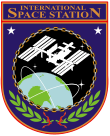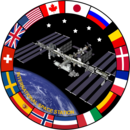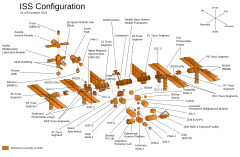
International Space Station
Largest modular space station in low Earth orbit / From Wikipedia, the free encyclopedia
Dear Wikiwand AI, let's keep it short by simply answering these key questions:
Can you list the top facts and stats about International Space Station?
Summarize this article for a 10 years old
The International Space Station (ISS) is the largest modular space station in low Earth orbit. The project involves five space agencies: the United States' NASA, Russia’s Roscosmos, Japan’s JAXA, Europe’s ESA, and Canada’s CSA.[11][12] The ownership and use of the space station is established by intergovernmental treaties and agreements.[13] The station serves as a microgravity and space environment research laboratory in which scientific research is conducted in astrobiology, astronomy, meteorology, physics, and other fields.[14][15] The ISS is suited for testing the spacecraft systems and equipment required for possible future long-duration missions to the Moon and Mars.[16]
.jpg/240px-The_station_pictured_from_the_SpaceX_Crew_Dragon_5_(cropped).jpg) Oblique forward view in November 2021 | |
  International Space Station program insignia | |
| Station statistics | |
|---|---|
| COSPAR ID | 1998-067A |
| SATCAT no. | 25544 |
| Call sign | Alpha, Station |
| Crew |
|
| Launch | 20 November 1998 (24 years ago) (1998-11-20) |
| Launch pad |
|
| Mass | 450,000 kg (990,000 lb)[3][full citation needed] |
| Length | 109 m (358 ft) (overall length), 94 m (310 ft) (truss length)[4] |
| Width | 73 m (239 ft) (solar array length)[4] |
| Pressurised volume | 1,005.0 m3 (35,491 cu ft)[4] |
| Atmospheric pressure | 101.3 kPa (14.7 psi; 1.0 atm) 79% nitrogen, 21% oxygen |
| Perigee altitude | 413 km (256.6 mi) AMSL[5] |
| Apogee altitude | 422 km (262.2 mi) AMSL[5] |
| Orbital inclination | 51.64°[5] |
| Orbital speed | 7.66 km/s[5][failed verification]27,600 km/h; 17,100 mph |
| Orbital period | 92.9 minutes[6] |
| Orbits per day | 15.49[5] |
| Orbit epoch | 16 August 16:19:30 [7] |
| Days in orbit | 24 years, 10 months, 9 days (29 September 2023) |
| Days occupied | 22 years, 10 months, 27 days (29 September 2023) |
| No. of orbits | 141,117 as of August 2023[update][7] |
| Orbital decay | 2 km/month |
| Statistics as of 22 December 2022 (unless noted otherwise) References: [4][5][8][9][10] | |
| Configuration | |
 | |
The ISS programme evolved from the Space Station Freedom, a 1984 American proposal conceived by Ronald Reagan[17] to construct a permanently crewed Earth-orbiting station,[18] and the contemporaneous Soviet/Russian Mir-2 proposal from 1976 with similar aims. The ISS is the ninth space station to be inhabited by crews, following the Soviet and later Russian Salyut, Almaz, and Mir stations and the American Skylab. It is the largest artificial object in the Solar System and the largest satellite in low Earth orbit, regularly visible to the naked eye from Earth's surface.[19][20] It maintains an orbit with an average altitude of 400 kilometres (250 mi) by means of reboost manoeuvres using the engines of the Zvezda Service Module or visiting spacecraft.[21] The ISS circles the Earth in roughly 93 minutes, completing 15.5 orbits per day.[22]
The station is divided into two sections: the Russian Orbital Segment (ROS) is operated by Russia, while the United States Orbital Segment (USOS) is run by the United States as well as other countries. The Russian segment includes six habitable modules. The US segment includes seven habitable modules, whose support services are distributed 76.6% for NASA, 12.8% for JAXA, 8.3% for ESA and 2.3% for CSA. The length along the major axis of the pressurized sections is 218 ft (66 m), and the total habitable volume of these sections is 13,696 cu ft (387.8 m3).[4]
Roscosmos had previously[23][24] endorsed the continued operation of ROS through 2024,[25] having proposed using elements of the segment to construct a new Russian space station called OPSEK.[26] However, continued cooperation has been rendered uncertain by the 2022 Russian invasion of Ukraine and subsequent international sanctions on Russia, which may cause changes in funding on their side of the space station.[23][24]
The first ISS component was launched in 1998, and the first long-term residents arrived on 2 November 2000 after being launched from the Baikonur Cosmodrome on 31 October 2000.[27] The station has since been continuously occupied for 22 years and 331 days,[28] the longest continuous human presence in low Earth orbit, having surpassed the previous record of 9 years and 357 days held by the Mir space station. The latest major pressurised module, Nauka, was fitted in 2021, a little over ten years after the previous major addition, Leonardo in 2011. In January 2022, the station's operation authorization was extended to 2030, with funding secured within the United States through that year.[29][30] There have been calls to privatize ISS operations after that point to pursue future Moon and Mars missions, with former NASA Administrator Jim Bridenstine stating: "given our current budget constraints, if we want to go to the moon and we want to go to Mars, we need to commercialize low Earth orbit and go on to the next step."[31]
The ISS consists of pressurised habitation modules, structural trusses, photovoltaic solar arrays, thermal radiators, docking ports, experiment bays and robotic arms. Major ISS modules have been launched by Russian Proton and Soyuz rockets and US Space Shuttles.[32] The station is serviced by a variety of visiting spacecraft: the Russian Soyuz and Progress, the SpaceX Dragon 2, and the Northrop Grumman Space Systems Cygnus,[33] and formerly the American Space Shuttle, the European Automated Transfer Vehicle (ATV), the Japanese H-II Transfer Vehicle,[11] and SpaceX Dragon 1. The Dragon spacecraft allows the return of pressurised cargo to Earth, which is used, for example, to repatriate scientific experiments for further analysis. As of April 2022[update], 251 astronauts, cosmonauts, and space tourists from 20 different nations have visited the space station, many of them multiple times.